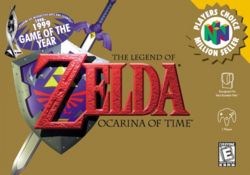The Legend of Zelda: Ocarina of Time

| |
| The Legend of Zelda: Ocarina of Time | |
| Developer | Nintendo |
| Publisher | Nintendo |
| System | Nintendo 64 Virtual Console |
| Release Date | Nintendo 64 JP November 21, 1998 US November 23, 1998 EU December 18, 1998 CH November 2003 Gamecube JP November 28, 2002 US February 28, 2003 EU May 3, 2003 Virtual Console US February 26, 2007 JP February 27, 2007 EU February 23, 2007 |
| Genre | Adventure |
| Gallery | GH Gallery |
| Rating | ESRB: E |
The Legend of Zelda: Ocarina of Time was The Legend of Zelda's jump to 3D. It's consistently called one of the best games for the Nintendo 64 and is often called one of the best games of all time.
Story
One day, the fairy Navi comes to Link to tell him the Great Deku Tree wants to talk to him. Once Link goes to the Great Deku tree, it tells him that he's been cursed and needs Link to go inside him and defeat the evil within. Link accepts the challenge and manages to defeat the evil. The Great Deku Tree tells Link that he is going to die and gives him one of the spiritual stones. He tells Link to find Princess Zelda and show her the stone. So, Link's epic adventure begins.
Gameplay
The gameplay is largely reinvented for a 3D environment as opposed to the overhead 2D controls of the previous games. In this game Link's main weapons are his sword and shield, which are assigned to certain buttons. Unlike in previous games, Link can perform a variety of different movements with his sword beyond the usual spin attack. The player can also equip three different weapons at a time by assigning them to different buttons. The items include a variety of new items as well as old items that have been retooled to work in 3-D. One of the other new features is horseback riding.
The game also contains a wide range of environments that contains not only monsters that must be vanquished, but friendlier locales filled with more distinctive characters than in the previous games as well as a variety of sidequests. Another unique feature was time traveling, as after a certain point in the game Link grows up but can return to the past and his child self by returning the Master Sword to its altar. There were certain items and features that could only be used by Child Link, and others that were exclusive to Adult Link.
Version Differences
Nintendo actually released three different versions of this game, excluding ports and remakes. Versions 1.0 was the gold cartridges released in 1998, Version 1.1 was the later gold cartridges, and Version 1.2 is the later gray cartridges.
- Version 1.0 has a glitch that allows the player to play without the Master Sword and use any item while riding Epona. At the end of the game, Ganon's blood is red.
- Version 1.1 fixed many of the bugs from Version 1.0. At the end of the game, the color of Ganon's blood changes with the color of the tunic Link wears.
- In Version 1.2, Ganon's blood is green. They also changed the music in the Fire Temple because it contained an Arabic phrase that translates to "I bear witness that there is no God, but Allah." This was found offensive by the Muslim community.
- In the Gamecube versions of the game, the star and crescent symbol used by the Gerudos was changed to the symbol used by the Gerudo pirates in The Legend of Zelda: Majora's Mask due to further complaints.
Legacy
Sequels
The Legend of Zelda: Ocarina of Time was followed by The Legend of Zelda: Majora's Mask. The sequel used the same basic engine, but included a unique three-day cycle as well as new items and the ability for young Link to ride Epona.
Ports and Rereleases
- In February 15, 2003 The Legend of Zelda: Ocarina of Time Master Quest was made available as a preorder bonus for The Legend of Zelda: The Wind Waker. This bonus disc contained both the original Ocarina of Time and a new Master Quest. The Master Quest, which was originally going to be released for the 64 DD prior to its failure, was an enhanced version of Ocarina in which the dungeons were redesigned to be harder in a manner similar to the "second quest" of The Legend of Zelda.
- In November 2003, The Legend of Zelda: Ocarina of Time was included in The Legend of Zelda: Collector's Edition promotional disk for the Nintendo Gamecube.
- The Legend of Zelda: Ocarina of Time was released on the Wii's Virtual Console in 2007. A demo version was included in Super Smash Bros. Brawl as an unlockable Masterpiece.
- A graphically updated version is being developed for the 3DS. This version also includes the Master Quest as an option.
See Also